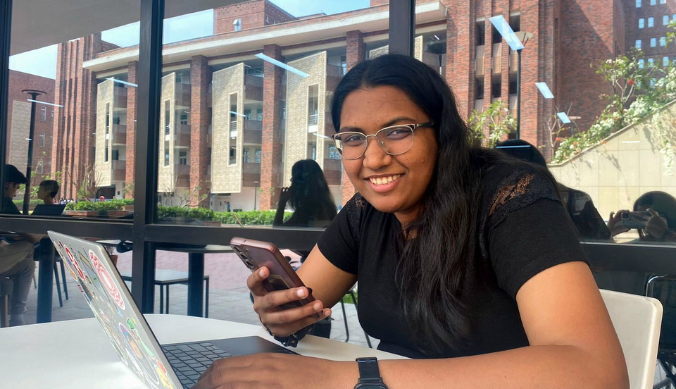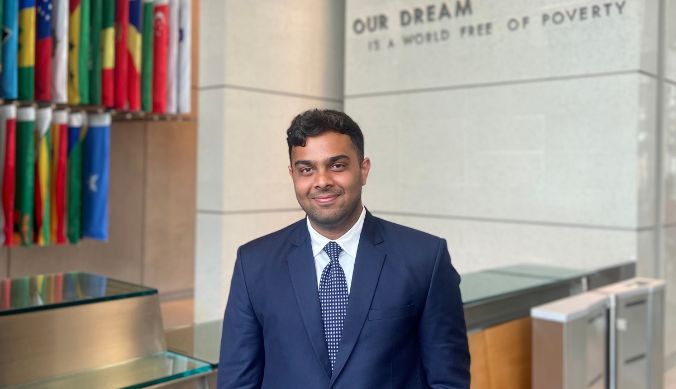Ashokapreneur Highlight: Amaan Andicot, Co-Founder, Finforall
This case blog captures the story of Finforall’s journey from inception to getting acquired and everything in between
The creation of the asset
After graduating from Shiv Nadar School, Gurgaon in 12th grade, Aayush decided to take a gap year to “take a break from academia”. In that period, he caught wind of a vicious cycle wherein, kids never really got comfortable with money and thus rarely sought to figure out how to earn more of it or allocate it intelligently, apart from the standard of getting a job and putting the money that’s left over into FDs and some mutual funds that their uncle recommends. Due to poor financial habits, many people are left with a far lower amount of money than they would have if they had practised fiscal discipline. A lack of money is not the ideal situation to be in and not talking about it makes the situation worse. Aayush resolved to break this money taboo.
He did so, by starting an Instagram page which went by the name of Finforall.
With what little savings he had, Aayush hired a graphic designer part-time and focused on brand building. He ran continuous experiments on social media pertaining to the content and found that brief and concise articles interwoven with clean, yet vibrant illustrations worked very well with audiences (who at the time were friends and their extended social circles). What worked for Finforall was that carousels (a new content format on Instagram at the time) gained a significant amount of traction and were seeing farther reach than just utilising pictures and slapping articles down in the caption (which was what Finshots – the only player in the market at the time was doing). He doubled down on this new form of content by using illustrations coupled with articles that could be read in no more than 3 minutes and pushing it to the designer to have it drawn out in creatives wherein, the content took centre stage. Within the first few months of going live, Finforall had crossed the 10k follower base mark. This follower count is important as per data from social blade spanning hundreds of pages, the founders realised that the algorithm Instagram uses to push out content to new audiences goes into overdrive once a page crosses 10,000 followers.
Getting to the 10k mark is arguably one of the hardest milestones to achieve on an Instagram page as growth primarily must either be: 1) inorganic (leveraging Instagram ads) which puts engagement at risk, or 2) via word of mouth which is extremely difficult to achieve.
Aayush found that Finforall was in a unique position. Given the surge of interest that took place during the pandemic for investing and the increased amount of screentime people put in towards social media, there was latent demand just waiting to be tapped and no player in the market was capitalizing on it. This first-mover advantage enabled Finforall to scale aggressively and that too, organically (i.e – with 0 ad spends). At the time, Finshots had total dominance on the newsletter segment; however, Instagram was a relatively underutilized platform on the topic of Finance. Thus, less competition and strong demand from consumers made Aayush plough on with Finforall, eventually rolling out podcasts that were available on Spotify, Apple Music and all major platforms. These podcasts hosted industry legends like Matt Dajer from Yes Theory (a prominent YouTube page), Tanmay Bhat from AIB & Nikhil Kamath, Co-Founder of Zerodha.
Eventually, Finforall scaled to 50,000 followers and Aayush had burned over Rs. 2,00,000 into the project without any sight of obtaining a return on the capital invested.
Entry of a co-founder
Finforall as a company started with a very specific chance interaction. While out on a family vacation to Rishikesh, Amaan happened to get acquainted with an HNI. Upon learning about Amaan’s interest in investing and his track record over the years, the strategies and rationale behind the investments made, the HNI offered to sign Amaan a cheque to kickstart a public market investment fund with a long-term investment horizon, if Amaan could provide a rationale behind the usage of the money. The catch: in the future or at any point in his career, if Amaan was to turn entrepreneurial and start a venture, the HNI would be issued equity as a sign of good faith. Secondly, in case of any capital losses, Amaan would be personally liable for paying him back his principal amount. The flip side to this was, that if Amaan were to consistently outperform the markets for a 5-year horizon, the HNI would up his stake in the fund and get other HNIs to invest with him. This was a deal of a lifetime for Amaan as it gave him exactly what he dreamt about…his own investment fund. This deal however came at a steep cost.
Pressed with this decision, Amaan reached out to Aayush, an old friend and a devil’s advocate. After hearing about the terms of the deal, Aayush simply advised “don’t do it, dude”. Instead, he came up with another proposal. He threw Amaan an offer to own half of Finforall as a Founder and to create a business model around it. Aayush was creative with his solutions to problems, while Amaan was an executor who’d bring ideas to life.
Equity Split
Aayush and Amaan didn’t want to needlessly inflate the value of the business especially when there is no revenue or profit to justify such a steep increase. While Amaan was adamant about getting in at the lowest possible valuation as Finforall was just one year old at that time, Aayush felt strongly that he had taken on a disproportionate amount of risk doing it alone full-time for an entire year, investing his savings and taking a gap year with no clear ROI. Finally, it was decided that Amaan would buy a 50% stake off of Aayush. This enabled the valuation to stay low enabling Amaan to get in on the ground floor, i.e – keeping the business valued at Rs. 4 lakhs while compensating Aayush for his risk-taking. Thus, they agreed on a 50-50 equity split.
Both founders had seen many businesses fail due to irreconcilable differences among the founders, which eventually permeated into other issues. So, both of them would regularly talk through why a certain course of action was better and if the other wasn’t convinced, they would drop the idea altogether. Such a style worked given a high degree of alignment among their values. They were striving to create a cash-compounding machine and one that was not only sustainable but profitable, to begin with.
Structuring out the Company: The Birth of a Business Model
The founders found out that they had a concentrated niche of:
- 24-35-year-olds
- A healthy mix of both genders
- People have either just started working or have limited work experience
- Educated audience with basic knowledge about personal finance
- Possession of savings that can be invested and used 1-2 Bank Accounts
The founders realised that the readers were their greatest asset. To be the customer acquisition channel for finance-based startups, Finforall started offering digital marketing services. It did so by running integrated posts for reputed fintech Brands and financial services companies. So:
- Finforall positioned itself at a premium price point given the high quality of audiences.
- The first ad campaign run was for CoinDCX.
Following a stringent KYC process Finforall only promoted brands which fit at least one of the two categories:
- Founders had used the product/service themselves and felt satisfied.
- The product/service would be of value to their readers.
This helped Finforall, retain the trust of their audiences. Simply put, they put their ear to the ground, studied vast amounts of data and tried to diagnose what problems the audiences faced and how those problems could be solved.
This eventually led to the need to expand the team. Finforall was operating at a very small scale and the founders had to get creative with the hiring process. Knowing that beaten-down stocks tend to trade for lower than even their cash value on the books, they adopted a similar strategy for hiring:
- Find meritorious prospects that have the academic calibre and domain experts but lack soft skills.
- These prospects got passed on for numerous prestigious internships or jobs.
- This in turn enabled Finforall to have high bargaining power with their hires and the hires accepted below industry standards for pay.
This allowed Finforall to expand aggressively while keeping its costs in check. Barring a token salary, all profits that were borne after paying off the entire team’s salaries were ploughed right back into the business, leading to huge profits.
Finforall leveraged the user feedback – there was a high demand for people to learn investing. There was a lack of solid offerings in the market. So Finforall went ahead and handcrafted a course for a batch size of 30 seats (later raised to 50). Rationale – quality came first above all else and only serious candidates were granted seats. The USP of the course was simple – the course provided meritorious members with a shot at working with a highly prestigious hedge fund based in India. Finforall was happy to discover the product market fit – receiving 250 applicants within the first 48 hours of opening up the course to their focus groups. The course was priced at Rs. 3,499 a seat. Courses having a zero marginal cost of replication allowed them to remain asset-light.
An Opportunity to Raise Investment
Due to the traction, Finforall enjoyed a YCombinator-backed startup that wanted to explore the possibility of investing in the company. The founders flew down to Mumbai, however, after preliminary discussions Aayush and Amaan decided against raising investment given that they didn’t need the capital at that stage and so this would be needlessly diluting the equity. The idea was to remain bootstrapped for as long as possible.
Competitive Pressures
Inspired by the traction received by Finforall, new players started entering the market. Due to increased competition, organic growth for Finforall began to stall.
This is when the founders turned to utilising data and tried to assess what kind of content could go viral. The strategy coupled with targeted inorganic expansion got the growth engine back into full gear.
During this period, barely anybody was advertising on social media. Ad spends were as low as Rs 0.5-0.75 per account. For context, when the advertising boom followed a few months later, ad spending jumped to figures as high as Rs. 2-5 per account reached. Inorganic forms of growth helped Finforall reach the 75k follower mark. This led to significant attention from multiple brands and deal flow began to resume.
In this time period, many foreign clients were opening up shops in India and Finforall became their favourite to advertise with given its audience composition.
Inflow from foreign clients = Need of reaching audiences with high net worths = Competition for limited ad space on Finforall = Pricing Power, given brand value.
Navigating the Acquisition
In December 2021, a foreign hedge fund managed to obtain an overseas direct investment licence from the RBI. This fund was making waves at that time featuring in Sucheta Dalal’s Moneylife, ET, and Financial Express (to name a few). This hedge fund was keen on running an integrated ad campaign on Finforall. The hedge fund turned out to be the dream client for Finforall. Firstly, it paid the full amount upfront which is rare when it comes to running campaigns. Secondly, a single integrated post that Finforall ran for them generated $23,000 worth of investments for the fund. Thus, they were keen on exploring the possibility of acquiring Finforall.
The hedge fund was happy to close the deal on the terms that the founders put forth and executed the transaction quickly. Amaan and Aayush knew the euphoria in the market wasn’t going to last forever and if they were to take their chips off the table, then that was the time. Their mentor of sorts offered to float the acquisition offer around to see if he could get them a better deal than what was on the table. The founders also consulted an industry veteran regarding the market behaviour and that confirmed their hypothesis.
The very next day, their contact returned with two buyers. One Jupiter – a neo-bank and the second NeoPay – an Indian e-commerce system and payments processor for teens. Finforall had 3 potential buyers at the table which gave the founders the ability to negotiate the best possible deal by staking one offer against the other.
Eventually, the hedge fund applied pressure on insisting on closing the deal within the following week. This forced the founders to negotiate more aggressively with the other potential buyers. In the end, they narrowed it down to 2 potential avenues:
Jupiter – same target groups, highly experienced management, ideal culture fit for Finforall. The valuation was at 21x Revenue which was better than the hedge fund deal. Additional Clauses: 3-year non-compete post-1-year binding employment contract to oversee the transition.
Hedge Fund – Faster closure of the deal, more tax efficient (transaction in cash), news articles on both founders regarding the acquisition, no binding clauses or non-compete.
The Jupiter deal was of larger ticket size, and was a better fit for Finforall but came with sharp consequences. The Hedge fund deal on the other hand gave the founders the freedom to do what they wanted as soon as the transaction was closed. This was ideal given the fact that they were attempting to perform a hostile majority stake takeover on a similarly sized competitor of Finforall due to fundamental differences between their stakeholders. What worked against the Hedge Fund deal was the pressure to decide quickly.
In addition to this, Amaan and Aayush had never been able to get onto a video call with the hedge fund buyers. On the other hand, Jupiter’s management was more than communicative. During the entire acquisition saga, the founders noticed that the Hedge Fund’s Chief Investment Officer was slated to come onto a prestigious conclave/summit that happens once a year and is run by an extremely reputed media house. Looking at the image of the CIO, they ran a backwards search only to find out that that’s not him, but rather a stock image of a “businessman” that’s been used in 14 different places including MensHealth!
The term sheet for both deals came in on the same day. They went ahead with Jupiter.
At the time of pitching, Finforall had a follower base of 132K, reached 1,032,118 accounts and garnered over 6,128,000 impressions over a 90-day period. The page had a baseline engagement rate of 3.48%.
Keywords:
- Traction = Follower Growth
- Engagement Rate = For social media pages, it is calculated as:
(Likes+Comments+Saves+Shares) / Total Follower Base
The higher the engagement rate of a page, the better the page is from a quality standpoint.
- Carousels = a slideshow format of putting together photos in the same Instagram post
By Amaan Andicot (ASP’23) & Avnie Garg (YIF’20)










